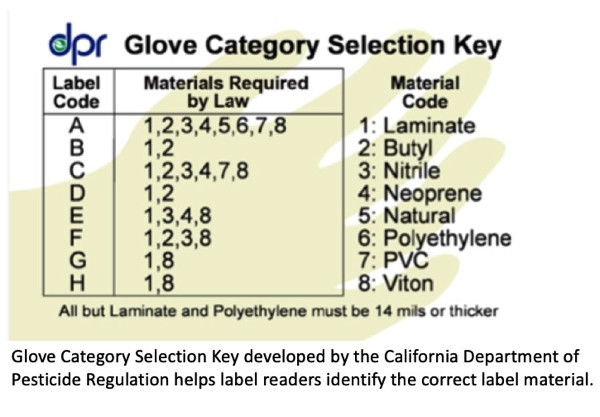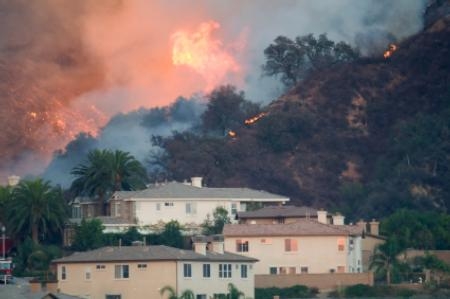- Author: Rose Marie Hayden-Smith
Current fire activity in Ventura County reminds us that fire season is here. It's critical to be prepared. Here are some important resources to help you get ready and stay apprised of fire activity in Ventura County.
For the latest fire incident information, visit the Ventura County Fire Department website. This website also contains a wildfire action plan for farmers, ranchers and growers.
We also suggest you bookmark the VC Emergency portal. You can access the Ventura County Emergency Preparedness Guide in English and Spanish.
Here are other resources we recommend:
- Fire in California This is UC ANR's comprehensive fire resources website. This site contains the latest information on fire ecology; wildfire preparation; health and safety in wildfires; wildfire recovery; and more. Useful information for homeowners, land owners and land stewards.
- CA Fire Science Consortium is a network of scientists and managers that strives to increase the awareness, understanding, and adoption of wildland fire science information.
- LUC Lab at UC-Berkeley researching land and land use change.
- ReadyForWildfire.org CalFire's fire resources website, which provides many valuable resources for preparedness.
- **NEW Wildfire Risk to Communities maps by US Forestry Service
Be sure to follow our UCCE Livestock & Range page on Facebook. Advisor Matthew Shapero helms that page and often posts fire information there. If you haven't had an opportunity to meet Matthew, you can learn more about his work in this blog post.
ICYMI, here's a #goodread about Pandemic and Wildfire: California is Preparing for a Crisis Within a Crisis
Stay safe.
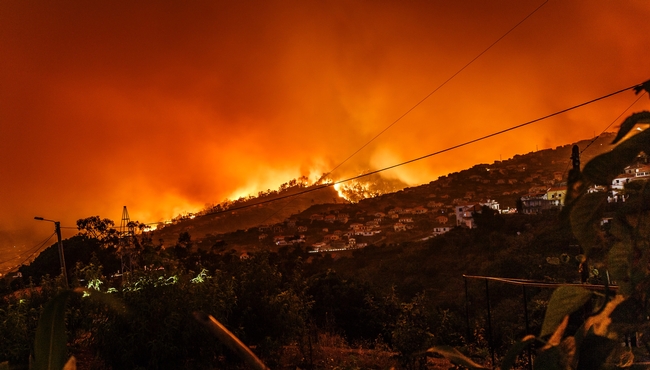
This piece appears elsewhere on the UC ANR website and was written by:
Lisa Blecker, coordinator for the UC Pesticide Safety Education Program and Office of Pesticide Information and Coordination
Whitney Brim-DeForest, UC Cooperative Extension rice advisor in Sutter and Yuba counties.
Katrina Hunter, UC Integrated Pest Management Program pesticide safety writer
Pam Kan-Rice, UC ANR Assistant Director, News and Information Outreach

With increased demand for personal protective equipment, or PPE, to protect against COVID-19, these essential workers are facing shortages. Agricultural commissioners in 28 counties are hearing from farmers who are having trouble getting PPE for their employees and farmers in another 11 counties who are worried about running out of PPE in the next month or twoaccording to a California Department of Pesticide Regulation survey.
Gloves, N95 respirators, coveralls and other gear that workers wear to protect themselves from COVID-19, pesticides, dust and other health hazards are in short supply as priority is given to health care workers during the pandemic.
To reduce the spread of COVID-19, workers may wear homemade face coverings, but for applying pesticides, they must wear respirators specified on the pesticide product label, said Whitney Brim-DeForest, UC Cooperative Extension rice advisor.
Pesticide applicators may use gear that is more protective than required by the product label and regulations.
“Although this could change in the days ahead, half-mask and full-mask respirators are more available than disposable N95 respirators for now,” said Lisa Blecker, coordinator for the UC Pesticide Safety Education Program.
Before the pandemic, 10% of N95 respirators from 3M went to health care, but that number is now 90%, the company said in a letter to distributors. This has led to significant backorders of PPE supplies for distributors.
Carl Atwell, president of Gempler's, an online distributor of worker supplies, said that before the crisis, normal lead times for PPE was up to 10 days. He estimated disposable respirators will become available in the fall and other PPE supplies in August.
In the meantime, there is alternative PPE that agricultural professionals can use during the shortage.
Atwell suggests looking for lesser known brands of PPE as opposed to the first tier of choice: “It's sort of like searching for Purell hand sanitizer. Purell brand might be out of stock, but can you find a different disinfectant?”
On Gempler's website, the more recognizable Tyvek coverall from Dupont is sold out, however disposable protective clothing is available from other brands. Reusable chemical-resistant clothing is also available as opposed to their disposable counterparts. Supplies in high demand are reusable and disposable nitrile gloves, protective clothing, disposable respirators and certain protective eyewear, such as goggles and face shields.
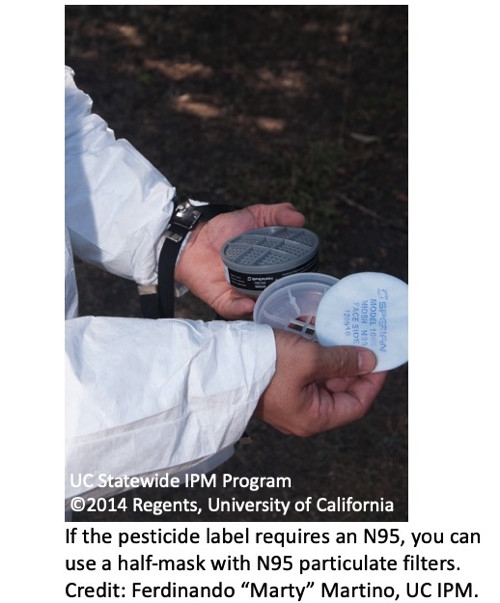
General PPE requirements: “Remember, the label is the law,” said Brim-DeForest. “PPE requirements for agriculture are not being loosened.” The UCCE advisor recommends purchasing only what you need for the season and choosing reusable PPE whenever possible. Growers who have excess supplies of PPE can coordinate with their county agricultural commissioner or UCCE advisor to help other producers in their area.
Respirators: If you can't find the respirator required on the label, Blecker said, “Use an alternative, more-protective respirator. For example, if an N95 is required, you can use a half-mask with N95 particulate filters; these can be stand-alone filters or ones that attach to an organic vapor cartridge. You could also use a different pesticide that doesn't require a respirator. Consult with your PCA (pest control adviser) for options.
”Gloves: Chemical-resistant gloves, usually 14 mil or more in thickness are required for most California pesticide applications and should be worn by mixers, handlers and applicators. If nitrile gloves are not available, viton and laminate gloves are universal chemical-resistant materials for most pesticide labels. If the glove material is specified on the label, that instruction must be followed.
“Disposable gloves less than 14 mil can be worn, but not for more than 15 minutes at a time, ”Blecker said. “Farmers should also note that thinner gloves cannot be layered on top of one another.”
Coveralls: Coveralls should be worn when required by the pesticide label or when the signal word is “WARNING” or “DANGER,” or when applying by backpack or airblast. “Coveralls can be made out of high-density polyethylene fibers (Tyvek and other brands), which are disposable, or cotton, which are reusable,” Brim-DeForest said. “If reusable coveralls are worn, the employer must ensure employees are provided clean coveralls.”
Goggles/face shields: Face shields are required for mixing and loading pesticides only if it's stated on the label. “If a face shield is unavailable, a full-face respirator can be used,” Blecker said. “Goggles or protective eyewear should always be worn in California when handling pesticides, regardless of what the label says. The face shield, goggles or safety glasses must provide front, side and brow protection and meet the American National Standards Institute Z87.1 standard for impact resistance.
For more information about PPE, contact your county agricultural commissioner or see the California Department of Pesticide Regulation's posters at:
https://www.cdpr.ca.gov/docs/whs/pdf/gloves_for_pesticide_handling.pdf and
https://www.cdpr.ca.gov/docs/whs/pdf/n95_alternatives_for_pesticide_handling.pdf.
UC IPM also covers these topics in their pesticide safety webinar series at:
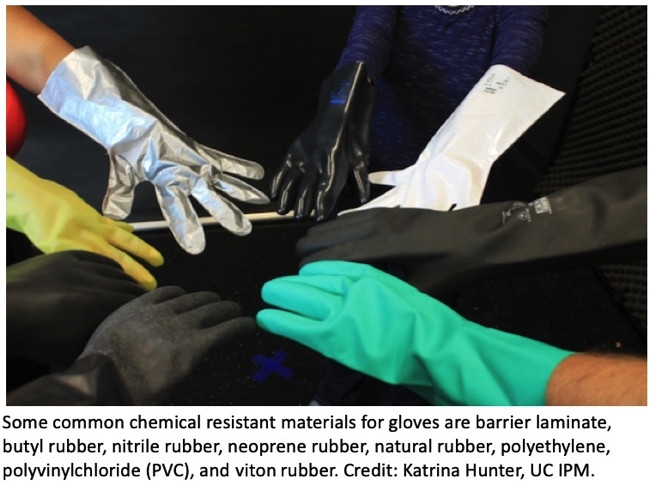
- Author: Cris L. Johnson

The University of California Cooperative Extension in Ventura County in conjunction with the USDA's Risk Management Agency will conduct presentations and simulations on managing risk for farm operations.
The prepaid cost (by Friday September 21) is $20 per farm/ranch couple. After September 21 the cost will be $25. The registration fee includes lunch and instructional materials.
For more information go directly to the registration webpage.
- Author: Chris M. Webb
UC ANR’s Spanish News Service website brings Agriculture and Natural Resource information to California residents who are fluent, and more comfortable learning, in Spanish. This is a vital service for all Californians as many of the issues and challenges we face together can only be solved by all of us working together.
This highly organized, visually appealing, and easy to navigate site provides a great deal of information on many important topics. The information can be accessed by audio, video, articles, and blogs.
Topics include:
- Invasive species
- Water quality
- Nutrition and fitness
- Child development
- Preventing obesity and overweight
- Reducing the risk of diabetes
- Natural resources
- Recovering from a natural disaster
- Integrated Pest Management (IPM)
- Preventing and recovering from wildfires
- Money management
- Gardening
- And much more
A similar site is available in English.
- Author: Chris M. Webb
There are a large number of wasp species in California. Only a few species live a social life. Some of these wasps perform a great service by killing large numbers of plant-feeding insects and nuisance flies.
Left on their own, wasps are not a problem. They become a problem when they sting, or threaten to sting humans. Luckily there are steps to take to reduce the potential for interactions with these potential pests. UC ANR’s Yellowjackets and other social wasps publication can help.
Topics include:
- Identification and life cycle
- Injury or damage
- Management


